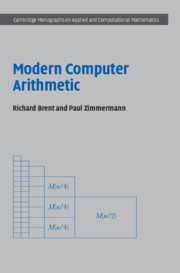2 - Modular arithmetic and the FFT
Published online by Cambridge University Press: 05 August 2012
Summary
In this chapter our main topic is modular arithmetic, i.e. how to compute efficiently modulo a given integer N. In most applications, the modulus N is fixed, and special-purpose algorithms benefit from some precomputations, depending only on N, to speed up arithmetic modulo N.
There is an overlap between Chapter 1 and this chapter. For example, integer division and modular multiplication are closely related. In Chapter 1 we present algorithms where no (or only a few) precomputations with respect to the modulus N are performed. In this chapter, we consider algorithms which benefit from such precomputations.
Unless explicitly stated, we consider that the modulus N occupies n words in the word-base β, i.e. βn−1 ≤ N < βn.
Representation
We consider in this section the different possible representations of residues modulo N. As in Chapter 1, we consider mainly dense representations.
Classical representation
The classical representation stores a residue (class) a as an integer 0 ≤ a < N. Residues are thus always fully reduced, i.e. in canonical form.
Another non-redundant form consists in choosing a symmetric representation, say −N/2 ≤ a < N/2. This form might save some reductions in additions or subtractions (see §2.2). Negative numbers might be stored either with a separate sign (sign-magnitude representation) or with a two's-complement representation.
Since N takes n words in base β, an alternative redundant representation chooses 0 ≤ a < βn to represent a residue class.
- Type
- Chapter
- Information
- Modern Computer Arithmetic , pp. 47 - 78Publisher: Cambridge University PressPrint publication year: 2010

